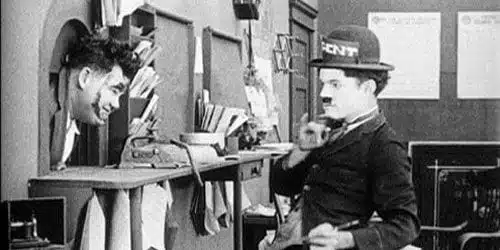
In Lawrence Ferlinghetti’s poem, “A Coney Island of the Mind”, he compares the poet to an acrobat who must “constantly risk absurdity and death” like a “little charleychaplin man.” Watching American Slapstick, Vol. 2, a three-disc DVD set featuring rare silent comedies (1915 – 1937) rescued from oblivion and presented with new musical scores, it is easy to turn the comparison around.
Slapstick comedy’s primary trope is loss of control — of the body, of one’s social standing, of a sense of propriety. This loss is the slapstick comedian’s gain, and the acrobats and physical comedians who represent this genre are surely poets of a kind.
Among its many offerings, American Slapstick, Vol. 2 gives us the early work of slapstick legend Harold Lloyd, shorts featuring Charlie Chaplin’s most successful imitator, Billy West, and an introduction (to the amateur silent film fan) to virtual unknowns like female slapstick comedians Alice Howell and Anne Cornwal.
It groups the shorts (33 in all, including a few cartoons) by subject, allowing the viewer to listen to a brief introduction that provides background to the films that follow. Given the slightly random nature of the rescued shorts, this important feature lets even novice silent film viewers appreciate how the films fit into the larger historical picture of silent film comedies.
Part One of the first disc contains early shorts starring Harold Lloyd. When he was just starting out, Lloyd played a Charlie Chaplin knockoff character called “Lonesome Luke.” Many of these works were destroyed by fire, but American Slapstick, Vol. 2 presents us with one of the few remaining Lonesome Luke films, “Luke Joins the Navy.” Here, shining through his Chaplin imitations is the hapless, ingratiating and smiley Lloyd we came to know later.
The “glasses period” Harold Lloyd comes out in charming films like “Don’t Shove”, which was my favorite of the group. Here, Lloyd tries to win a girl’s heart at her birthday party by eliminating his rival, played by Oliver Hardy (of Laurel and Hardy fame). The roller skating sequences in “Don’t Shove” are like ballets in reverse — choreographed for maximum gracelessness and ridiculousness.
Part Two of Disc One introduces us to the B-list actors who gained some fame in the “House that Lloyd built”, that is, the Hal Roach studios. These actors include Gaylord Lloyd (Harold Lloyd’s brother), James Parrot, Snub Pollard, and Larry Semon.
“Speed Demon”, starring Semon, showcases daring feats that are amazing by any era’s standards. Without special effects or any visible safety measures, the actors perform insanely dangerous stunts in this film about a race between two men to win the hand of a lady.
In one scene, Larry Semon accidentally hitches the sheriff’s bed to the end of his racecar. As the bewildered sheriff stands up hitched to a speeding car with bed sheets clinging to his face, the long shot of the car speeding down a road tells you all you need to know about how perilous this stunt was. With enough crashes, explosions and tumbles to fill a modern Hollywood film, “Speed Demon” impresses.
“Fresh Start”, starring Lige Conley and Jimmie Adams, tells the story of two ex-cons released from prison who try to get a new lease on life. They fall in love with a young showgirl, attempt to insinuate themselves into her home, undetected by her brute of a husband, and naturally, hijinx ensue.
The most amazing, Buñuel-esque sequence occurs when lions from a local zoo find their way into the home, leading to a surreal chase scene involving Conley, Adams, the husband and lions. In an incredible (and no doubt dangerous) scene, one of the cons locks himself in a room with a lion that decides to nap on his back as his socks literally curl off his feet with terror — the only special effects in the scene.
Disc two, “Chaplin Without Chaplin”, features Chaplin cartoons and his best imitator, Billy West, in shorts that supplied the demand for Chaplin he himself could not fulfill alone. But for my money, the funniest short in the entire box set is in the third disc: “Cinderella Cinders”, starring Alice Howell in one of her few films that survived in its entirety.
This frizzy-headed proto-Lucille Ball just happens to always find herself in the middle of zaniness. In “Cinderella Cinders”, she gets a job as a cook at a wealthy couple’s mansion. The couple receives word that a count and countess (actually con artists) are in town, and they decide to give Howell’s character and the butler she works with makeovers so that they, too, can pretend to be royalty.
Unfortunately, the cat knocks over a bottle of moonshine into the punchbowl, and pretty soon Howell is seeing double, lurching around, and mocking the lady of the house. Acting decidedly unladylike at a time when women were denied the vote and supposed to stay in the home, the lovely yet goofy Alice Howell will be one of many revelations American Slapstick, Vol. 2 offers the would-be silent film slapstick fan.
By the time the viewer reaches the talkie films in the third disc, films that attempted to bridge the silent form of slapstick with its talkie incarnation, one realizes that the absence of dialogue added to, rather than deprived, the films. The talkies are simply not as compelling as their silent versions.
A narrator in one of the introductions says that the American Slapstick series loves “the forgotten, the obscure, and the lost.” Lucky for us, these restored films — remembered, canonized, and restored — remind us of the vitality and joy that was early silent slapstick cinema.
